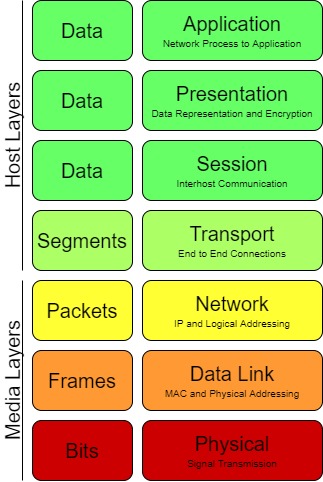The OSI (Open Systems Interconnection) model is a framework that divides the processes involved in networking into seven distinct layers, each of which performs a specific function. The layers are arranged in a hierarchy, with the lower layers focusing on the physical transmission of data and the higher layers concerned with how that data is interpreted and used.

The 7 Layers
Physical Layer
The physical layer is responsible for transmitting raw data over a physical connection, such as a cable or a wireless connection. It defines the type of medium being used and the bit rate at which data is transmitted.
Data Link Layer
The data link layer is responsible for establishing and maintaining connections between two nodes on a network. It breaks data down into frames and manages the transfer of those frames from one device to another. It consists of two sublayers: the logical link control (LLC) and the media access control (MAC). The LLC synchronizes frames, performs error checking, and identifies network protocols, while the MAC defines the rules for devices to transmit and receive data.
Network Layer
The network layer is responsible for routing packets of data across a network and finding the best path for them to take. It also divides data into packets and reassembles those packets on the receiving end. It uses internet protocol (IP) addresses to route packets to their destination.
Transport Layer
The transport layer is responsible for dividing data into segments on the sending end and reassembling it on the receiving end. It also handles flow control and error checking to ensure that data is transmitted correctly.
Session Layer
The session layer creates communication channels, known as sessions, between devices and manages the transfer of data over those sessions. It can also set checkpoints during data transfer so that if a session is interrupted, devices can resume from the last checkpoint.
Presentation Layer
The presentation layer prepares data for the application layer and defines how data should be encoded and compressed for transmission. It also takes data transmitted by the application layer and prepares it for transmission over the session layer.
Application Layer
The application layer provides protocols that allow software applications, such as web browsers and email clients, to send and receive data that is meaningful to users. It includes protocols such as HTTP, FTP, POP, SMTP, and DNS.
Why is the OSI Model Important?
The OSI model is important because it provides a standardized framework for understanding how networking functions work. It divides the complex process of networking into seven distinct layers, each of which performs a specific function. This allows different devices and systems to communicate with each other, even if they are from different manufacturers and use different technologies.
By breaking down the networking process into these distinct layers, the OSI model makes it easier to understand how different devices and systems communicate with each other and how data is transmitted between them. It also provides a common language that professionals in the field of networking can use to discuss and troubleshoot issues.
The OSI model is also important because it helps to ensure compatibility between different devices and systems. Because all devices and systems follow the same set of rules and protocols at each layer of the OSI model, they are able to communicate with each other successfully. This ensures that devices from different manufacturers can work together, even if they use different technologies.
Overall, the OSI model is an essential tool for understanding how networking functions and for ensuring compatibility between different devices and systems.
